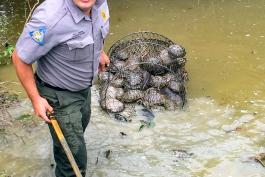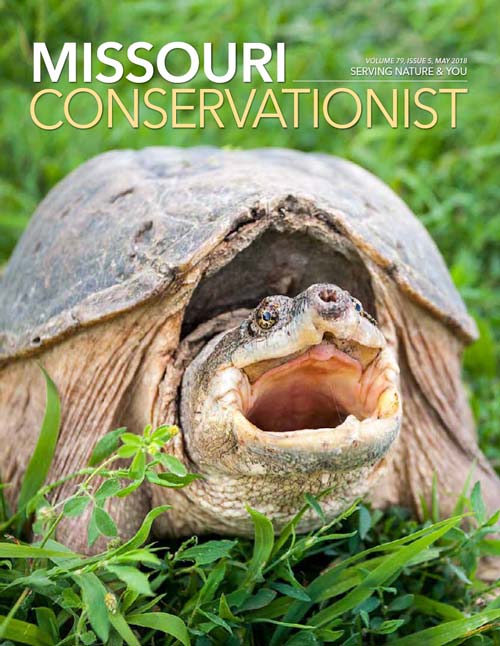Missouri is home to 18 species of turtles. Although turtles have been around for years, they are losing ground to land conversion, draining of wetlands, and channelization of rivers, which have replaced their preferred habitat — swamps, marshes, and, meandering streams. Poaching and congested roadways put added pressure on these ancient and important creatures. Add to this the commercial harvest of certain species of turtles — especially mature adults — to serve the demand in foreign markets, and it becomes clear why their populations are vulnerable throughout many regions of the world.
To help reverse this trend, MDC took an important step.
Commercial Harvest Closes
On March 1 of this year, Missouri joined many other states when it closed the commercial harvest of common snapping (Chelydra serpentina), smooth softshell (Apalone mutica), and spiny softshell (Apalone spinifera) turtles.
“From habitat loss and degradation, disease, mortality from road traffic, increased predation, water pollution, and harvest for food, medicines, and the pet market, turtles are constantly battling for their lives,” said Missouri State Herpetologist Jeff Briggler. “Elimination of commercial turtle harvest was needed to protect the long-term stability of turtle populations in the state.”
Prior to this regulation change, the Wildlife Code of Missouri allowed the harvest and possession of common snapping, smooth softshell, and spiny softshell turtles in any numbers throughout the year. Turtles could be taken from flowing portions of the Missouri and Mississippi rivers and the portion of the St. Francis River that forms the boundary between Arkansas and Missouri using commercial methods.
Commercial turtle harvest is considered one of the most important influences on turtles’ population declines worldwide, Briggler said.
“Most turtle species lay less than 20 eggs annually, and of those, less than 25 percent even make it to a juvenile stage,” Briggler said. “Then female maturation may take up to 10 years, depending on the species, which makes the replacement rate of just one turtle hard to come by. With limited egg production, there’s just no way to compensate for the removal of reproductive adults.”
Due to their hard, protective shell, turtles have few natural predators once they reach adult size. Therefore, turtles can be easily overharvested from a location and it can take decades — if not multiple decades — for the reduced population to rebound.
A Three-Year Study
To better understand the effects of commercial harvesting on the turtle population and to determine if regulation changes were necessary, MDC, in cooperation with the University of Missouri-Columbia, initiated a study in 2010. For three years, researchers conducted mock harvests on commercial waterways and compared that data with mock harvests conducted on noncommercial waterways. During the study, researchers acted as mock harvesters, using the same methods as commercial harvesters to collect species of turtles.
The numbers harvested were then calculated to obtain the abundance of turtles, proportion of turtles harvested, and to model the effects commercial harvesting had on river turtle populations.
Results showed that common snapping turtle populations were significantly lower in harvested areas, like the Missouri River, as compared to unharvested sites, like the lower Osage and Gasconade rivers.
“This was telling us that commercial harvesting may have already taken a toll on common snapping turtle populations in the Missouri River,” Briggler said.
“What was clear throughout the study was that a substantial portion of turtles — on average 23 percent — could be harvested using legal methods,” Briggler said. “Numbers obtained in this study indicated that commercial turtle harvesters had the potential to remove a sizeable proportion of harvestable turtle populations under the state’s regulations at that time.”
Modeling of the population characteristics of these turtle species confirmed what turtle biologists already knew — turtle populations rarely can be harvested without a slow, steady decline occurring.
Given the traits that make turtles vulnerable to overharvest, research collected on the effects of harvest, and input solicited from commercial harvesters, citizens, and conservation organizations via a mail-in survey, MDC proposed eliminating commercial turtle harvest in July 2017. Those changes went into effect the following March.
“For years, turtles have survived their natural predators using their hard, protective shells and longevity to reproduce over many years, but harvesting for foreign markets is a battle they can’t win in the long run,” Briggler said. “I know this change will go a long way in the protection of the turtle resources of the state, and ensure Missouri’s citizens will continue to see and utilize turtles in the future.”
Recreational Harvest: Limit Change
Although it is now illegal to harvest common snapping and softshell turtles for commercial use, it is still legal to take these three species in limited numbers for personal consumption. However, effective March 1, 2018 the daily limit for common snapping and softshell turtles was reduced from five each to two in the aggregate. The seasons and methods will remain the same — common snapping turtles may be taken throughout the year and softshell turtles from July 1 through Dec. 31 with hand or lines.
“Limited data exists on the number of turtles harvested via sport fish license,” Briggler said.
Based upon interactions with anglers and public input during MDC’s 80th anniversary open houses held across the state in 2017, very few individuals reported harvesting turtles for food.
“On average, 1.2 million anglers annually possess a fishing license and could potentially harvest turtles. That means annual harvest of turtles using sport fish methods could be very high,” Briggler said. “This reduction still allows individuals who enjoy eating turtle meat to possess these turtle species for food while ensuring long-term sustainability of the turtle resource of the state.”
Here's What You Can Do To Help
- Don’t adopt or buy turtles for pets. They require special care and can live well over 40 years.
- Don’t shoot turtles for sport. It’s illegal, and it pressures an already stressed group of animals.
- Report turtle poachers to Operation Game Thief toll-free at 1-800-392-1111.
- Be careful when you drive, especially in spring and summer when box turtles are mating, nesting, and dispersing. If you can do so safely, stop and help a turtle cross the road. Always move the turtle in the direction it is headed.
- Create habitat areas around your home or farm. These include wetlands and wooded, shrubby, and grassy natural habitat.














Also In This Issue


And More...
This Issue's Staff
Associate Editor - Bonnie Chasteen
Staff Writer - Larry Archer
Staff Writer - Heather Feeler
Staff Writer - Kristie Hilgedick
Staff Writer - Joe Jerek
Creative Director - Stephanie Thurber
Art Director - Cliff White
Designer - Les Fortenberry
Designer - Marci Porter
Photographer - Noppadol Paothong
Photographer - David Stonner
Circulation - Laura Scheuler






















